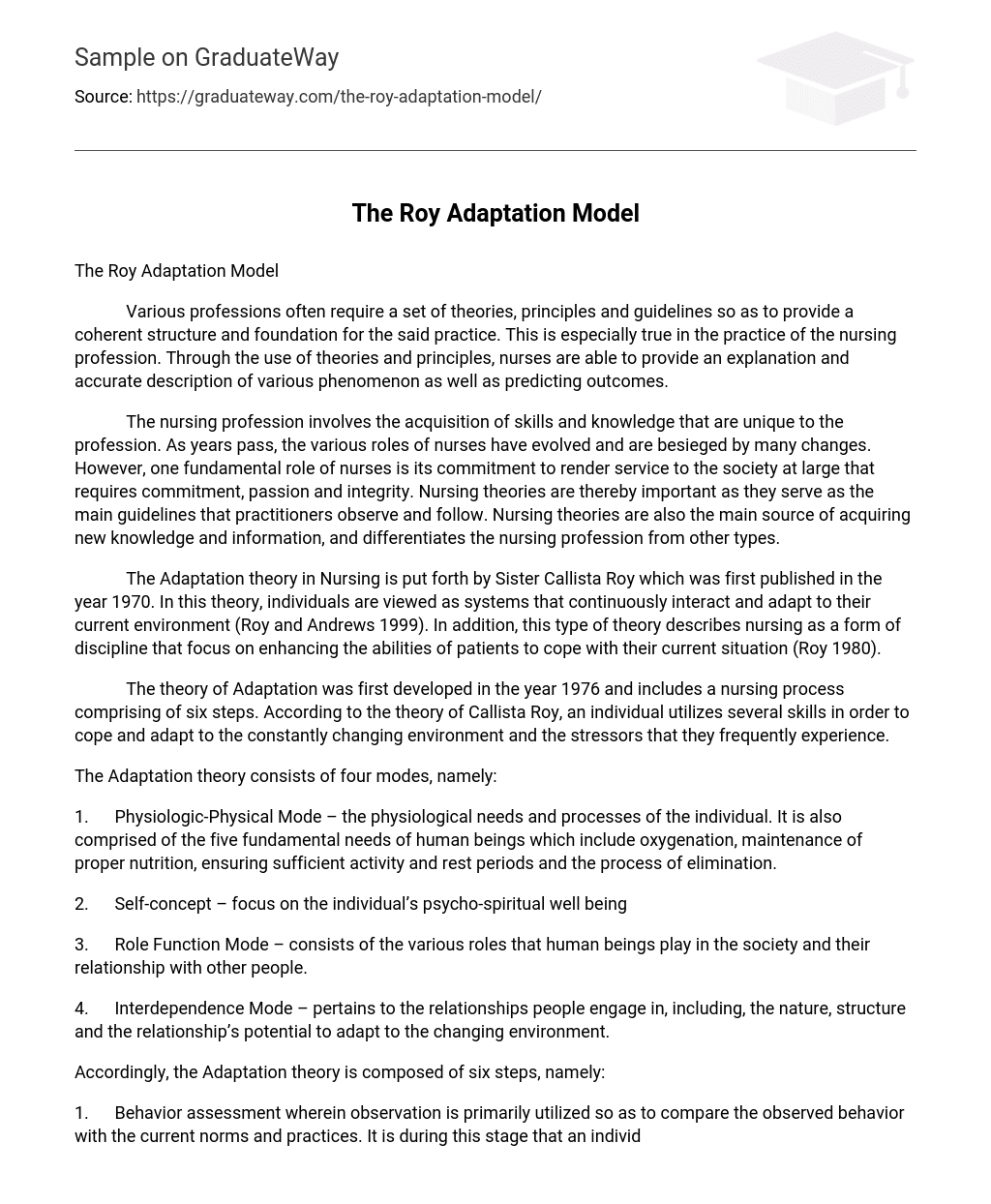Various professions often require a set of theories, principles and guidelines so as to provide a coherent structure and foundation for the said practice. This is especially true in the practice of the nursing profession. Through the use of theories and principles, nurses are able to provide an explanation and accurate description of various phenomenon as well as predicting outcomes.
The nursing profession involves the acquisition of skills and knowledge that are unique to the profession. As years pass, the various roles of nurses have evolved and are besieged by many changes. However, one fundamental role of nurses is its commitment to render service to the society at large that requires commitment, passion and integrity. Nursing theories are thereby important as they serve as the main guidelines that practitioners observe and follow. Nursing theories are also the main source of acquiring new knowledge and information, and differentiates the nursing profession from other types.
The Adaptation theory in Nursing is put forth by Sister Callista Roy which was first published in the year 1970. In this theory, individuals are viewed as systems that continuously interact and adapt to their current environment (Roy and Andrews 1999). In addition, this type of theory describes nursing as a form of discipline that focus on enhancing the abilities of patients to cope with their current situation (Roy 1980).
The theory of Adaptation was first developed in the year 1976 and includes a nursing process comprising of six steps. According to the theory of Callista Roy, an individual utilizes several skills in order to cope and adapt to the constantly changing environment and the stressors that they frequently experience.
The Adaptation theory consists of four modes, namely:
1. Physiologic-Physical Mode – the physiological needs and processes of the individual. It is also comprised of the five fundamental needs of human beings which include oxygenation, maintenance of proper nutrition, ensuring sufficient activity and rest periods and the process of elimination.
2. Self-concept – focus on the individual’s psycho-spiritual well being
3. Role Function Mode – consists of the various roles that human beings play in the society and their relationship with other people.
4. Interdependence Mode – pertains to the relationships people engage in, including, the nature, structure and the relationship’s potential to adapt to the changing environment.
Accordingly, the Adaptation theory is composed of six steps, namely:
1. Behavior assessment wherein observation is primarily utilized so as to compare the observed behavior with the current norms and practices. It is during this stage that an individual’s behavior is classified as adaptive behavior (wherein the individual successfully adapts and maintain their integrity) and ineffective behavior (wherein individuals fail to adapt to the environment and consequently, does not achieve their goals).
2. Identification of stimuli that affect and influence an individual’s behavior. These can be further subdivided into:
a. Focal stimuli – stimuli that has an immediate effect on the human system.
b. Contextual stimuli – stimuli that are present in a given situation but is not considered as the focal stimuli.
c. Residual stimuli – stimuli that has an unknown effect.
3. The formulation of a nursing diagnosis that takes into account the objective and subjective cues and identification of the apparent cause.
4. Setting goals that are measurable, attainable, realistic and is agreed upon by the individual (Andrews and Roy 1991).Furthermore, the implementation process also focuses on enhancing the individual’s ability to cope and adapt to the current situation.
5. Implementation of the necessary interventions to achieve the stated goals
6. Evaluation of whether the goals have been met and reassessment of behaviors and steps that were taken.
The adaptation theory by Sister Callista Roy is very relevant in the nursing profession as it allows nurses to look at a person in a holistic manner by taking into account his physiologic, psycho-social, spiritual and emotional needs. In addition, the adaptation model also puts forth several guidelines and principles that nurses may utilize during the nursing process of assessment, diagnosis, planning, implementation and evaluation (Roy 1997).
Several weaknesses that have been identified in the Adaptation theory is the need for consistent and uniform definition of the operational terms and concepts that were utilized. In addition, further research is needed to establish the formal definitions and operational terms.
The strengths of the Adaptation model lie on the fact that it places a significant emphasis not just on the person as a whole but also towards the significant relationships of the individual within the society. It is place emphasis on the spirituality of human beings, an aspect that is frequently neglected by nurses during client assessment and provision of care or service. The adaptation model has also been frequently utilized in various researches and studies, thus making the adaptation model an evolving piece of work.
In the educational setting, the adaptation theory of Sister Callista Roy proves to be very useful as nursing students are taught holistically about the provision of care to patients and clients. The theory also reinforces the fundamental aspect of nursing, which is to enhance the ability of individuals to adapt to their various situations and work towards the goal of achieving optimal health and wellness.
References:
Andrews, H., & Roy, C. (1991). The Adaptation Model. Norwalk: Appleton & Lange.
Roy, C. (1980). The Roy adaptation model. In J. P. Riehl & C. Roy (Eds.), Conceptual models for nursing practice (2nd ed. pp.179-188). New York: Appleton-Century-Croft.
Roy, C. (1997). Future of the Roy model: Challenge to redefine adaptation. Nursing Science Quarterly, 10, 42-48.
Roy, C., & Andrews, H. (1999). The Roy adaptation model. Stamford: Appleton and Lange.





